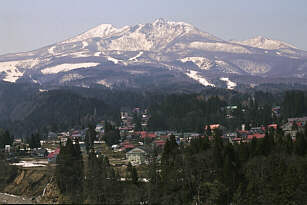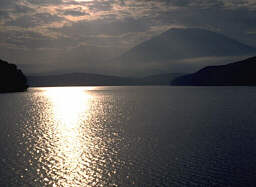
早春の妙高山 写真:藤田秀一 (1995)

「信濃の国」は長野県人なら誰でも知っている歌で、会合でよく歌われます。
信濃の国は十州に 境(さかい)連ぬる国にして1番の最後の2行は子供の頃は理解できませんでしたが、「海こそないが、豊かで、すべて足りないことはない」という意味であることを大人になって知りました。明治23年(1899年)に浅井洌(きよし)が作詞、明治33年(1900年)に北村季晴(みちはる)作曲。師範学校(現在の信州大学教育学部)でよく歌われ、卒業生が長野県の各学校で教え、子供たちにより歌われることとなり、昭和43年(1968年)に県歌として制定されました。
聳(そび)ゆる山はいざ高く 流れる川はいや遠し
松本、伊那、佐久、善光寺 四つに平(たいら)は肥沃の地
海こそなけれ物さわに 万(よろ)ず足(た)らわぬことぞなき四方に聳ゆる山々は 御嶽乗鞍駒ヶ岳
浅間は殊(こと)に活火山 いずれも国の鎮めなり
流れ淀まずゆく水は 北に犀川千曲川
南に木曽川天竜川 これまた国の固めなり木曽の谷には真木(まき)茂り 諏訪の湖には魚多し
民のかせぎも豊かにて 五穀の実らぬ里やある
しかのみならず桑とりて 蚕飼(こが)いの業の打ちひらけ
細きよすがも軽からぬ 国の命を繋ぐなり
この間も夜会社の帰り、東京・赤坂あたりの道路をを歩いていたら「信濃の国」の大合唱を耳にしました。足を止めて合唱が聞こえるビルの入り口を見たら、案の定「労働省関係長野県人会」という案内板がかかっていて、懇親会のお開きだったようです。
木曽節は長野県南西部の木曽地方の歌で、長野県の民謡の中でも最も広く全国に知られています。長野県内では、南西部を中心に各町・村で行なわれる盆踊りで使われています。
|
木曽のナァ 中乗りさん 木曽の御嶽さんは ナンジャラホイ 夏でも寒い ヨイヨイヨイ アラ ヨイヨイヨイノ ヨイヨイヨイ |
木曽川のいかだ流し3人組みの 真ん中を漕ぐ お頭さんと 木曽の御嶽山は どういう関係かね。 上の御嶽山は夏でも寒くて、下の木曽川は夏でも涼しいのさ。 |
「木やり」というものを最近信州の結婚式やお葬式後の会食で歌う人がいますが、これは何を歌っていて、どういうところから来た習慣でしょうか。私の子供の頃はなかった習慣です。木曾地方の「木やり歌」の習慣が北信に伝わったものでしょうか。
長野県は山に囲まれた海なし県で、言葉や習慣の違いから、
ページのトップ | 日本語部分 | 英語部分 | アジア情報ネットワークのホームページ

The Province of Shinano (Shinano no Kuni) is the official prefectural song which all Shinshu-ites know and which is sung quite frequently at any meetings.
The Song of Nagano Prefecture in English: La chanson du départment de Nagano en français : The Province of Shinano is the land
Which borders on ten other provinces.
The towerng mountains here are high, and
The running rivers flow very far.Matsumoto, Ina, Saku and Zenkoji
Are our four major basins with fertile soil.
Though there are no seas, we lack
Nothing else, and are a country rich in resources.La Province de Shinano est la terre
Qui est contiguë aux dix autres provinces.
Les hauts montagnes ici sont tres hauts, et
Les rivières coulent au tres loin.Matsumoto, Ina, Saku et Zenkoji
Sont les cuvettes majeures avec le sol fertile.
Ainsi qu'il n'y a pas de la mer, nous ne manquons
Rien, et sont un pays riche en ressources.
The high-rising mountains on the four sides are:
Ontake, Norikura, Komagatake and
Asama, an active volcano;
They are the foundation of our land.The rivers that flow incessantly are:
The Sai and the Chikuma in the north and
The Kiso and the Tenryu in the south;
They are the basis of our land.Les montagnes qui nous menacent dans quatre côtés sont :
Ontaké, Norikura, Komagataké et
Asama, un volcan actif ;
Ils sont la fondation du notre pays.Les rivières qui coulent incessantment sont :
La Saï et la Chikuma au nord et
La Kiso et la Tenryu au sud ;
Elles sont la base de notre pays.
Japanese cypress trees grow in the valleys of Kiso,
Fish are caught abundantly in Lake Suwa;
We earn our living in a good standing,
And which villages do not have enough grains?We still plant the mulberry trees
And grow silkworms for our living;
We are the experts in this trade
Which is in the basic fabric of our land.See for the English explanation in Nagano Prefecture home page and for the French translation in L'Association franco-japonaise de Nagano (The Franco-Japanese Association of Nagano) home page.
Kisobushi, a folk song of Kiso from Nagano Prefecture's southwestern region, is the most famous of the many folk songs originating from our prefecture. In Kiso-Fukushima Town and its neighboring areas, this song is used at the Bon festival dances, held on August 13-16 each year.
|
Kiso no na-a nakanori-san, Kiso no Ontake-san wa nanjarahoi ?
Natsu demo samui, yoi yoi yoi ! |
What do they have in common, Mt. Ontake in Kiso and The middleman leader of the 3-man team running the raft of Japanese cypress logs in the Kiso River ? It is cold even in summer up in the mountain, and so cool down here, too! |
TOP OF PAGE | JAPANESE PART | ENGLISH PART | ASIA INFO NETWORK HOME PAGE